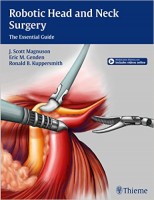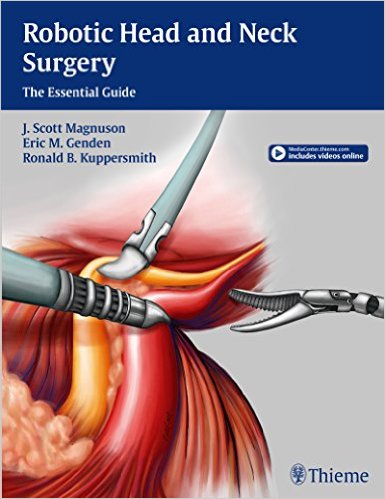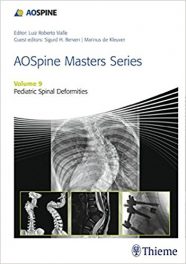 Editors: J. Scott Magnuson, MD; Eric M, Genden, MD; and Ronald B. Kuppersmith, MD
Editors: J. Scott Magnuson, MD; Eric M, Genden, MD; and Ronald B. Kuppersmith, MD
Publisher: Thieme – 186 pages
Book Review by: Nano Khilnani
Surgery of the head and neck using a surgical robot is relatively new, with many exciting future possibilities on difficult problems still in need of solutions. It was first used in cardiac surgery and urological operations, with other sections of the human body following later.
The surgeon using a robot enables him to access parts of the complex anatomy of the head and neck that are otherwise difficult to get to with manual surgery. Robotic surgery also enables him to approach his tasks from new perspectives. New procedures in head and neck surgery can also be more easily developed with the use of robots.
Computer and robot-assisted surgery of structures within the head and neck also allows for precision work that is not always possible with traditional surgery, especially when the hands of some surgeons may not be steady or when they are fatigued.
Twenty-five specialists including the editors authored the 16 chapters of this book. They are from the United States and Australia, India, Italy, Egypt, and South Korea. Most of them are professors or lecturers at various universities and / or physicians and surgeons at medical centers. Below we list the chapters of this book to give you a sort of bird’s eye view of what is covered in this book:
- The Contemporary History of Robotic Surgery
- Training and Education fir Robotic Surgery
- The Ethics of Surgical Innovation
- Room Setup and Instrumentation
- Robotic Surgery for Management of Oropharyngeal Malignancies
- Robotic Reconstruction of the Oropharynx
- The Prevention and Management of Complications in Robotic Surgery for Malignancy
- Robotic Surgery for Management of Sleep Apnea
- The Prevention and Management of Complications of Robotic Sleep Surgery
- Robotic Surgery of the Larynx
- Robotic Surgery of the Hypopharynx
- Robotic Surgery of the Parapharyngeal Space
- Transaxillary Robotic Thyroidectomy
- Robotic Neck Dissection
- Robotic Surgery of the Skull Base
- The Future of Robotic Surgery
In addition to the print material in this book shown above, access to electronic media is also available to purchasers. For example, you can find 10 videos on the treatment of squamous and spindle cell carcinomas online at www.MediaCenter.Thieme.com and when prompted during the registration process, enter this code o get started: 26C6-RLS8-EW59-5AR4.
Some of the topics covered in this book that are not clearly discernible from the chapters listed above, are the following:
- Approaches to malignancies
- Avoiding complications
- Basics of computer-assisted surgery
- Ethical considerations
- Instruments required
- Robotic surgery And sleep apnea
This is a useful book for many, and among them are the following:
- Surgeons interested in discovering, trying and adopting new techniques
- Otolaryngologists looking for insight on improving patient selection
- Robotic surgeons seeking new approaches for a variety of head and neck procedures
- Oncologists who treat patients with head and neck illnesses
This is a valuable resource on the relatively new practice of robotic surgery in treating head and neck diseases.
Menu of Accompanying Videos:
Video 5.1 TORS lateral oropharyngology for a T3N2b squamous cell carcinoma of the tonsil.
Video 5.2 TORS base of tongue resection for a T3N2b base of tongue squamous cell carcinoma.
Video 6.1 The preoperative findings on a patient with a tongue base cancer, demonstrating the resection of remucosalization that occurs six weeks after surgery.
Video 6.2 Surgical resection of a tonsil cancer using robotic laser technique, demonstrating the use of a local pharyngeal flap reconstruction of the defect.
Video 10.1 TORS supraglottic laryngectomy for a T2N0M0 squamous cell carcinoma using Omniguide CO2 laser.
Video 10.2 TORS selective supraglottic laryngectomy for an infrahyoid T1N0M0 squamous cell carcinoma.
Video 10.3 A salvage TORS supraglottic laryngectomy for a T2N0M0 squamous cell carcinoma of the supraglottis.
Video 10.4 TORS total laryngectomy for a recurrent T2N0M0 posterior commisure spindle cell carcinoma.
Video 11.1 Transoral robotic resection of hypopharyngeal squamous cell carcinoma.
Video 14.2 Robot-assisted modified radical neck dissection including level I-V via retroauricular approach for a T2N2aM0 oral squamous cell carcinoma.
Editors:
J. Scott Magnuson, MD, FACs is Professor of Otolaryngology – Head and Neck Surgery at University of Central Florida College of Medicine; Chief Medical Officer at Florida Hospital Celebration Health; Medical Director odf Head and Neck Surgery at Celebration Health; Director of Robotic Head and Neck Surgery at Florida Hospital Nicholson Center for Robotic Surgery; and Board Member on its Global Faculty.
Eric M, Genden, MD, FACS is Professor and Chairman of the Department of Otolaryngology – Head and Neck Surgery at Icahn School of Medicine at Mount Sinai in New York, New York.
Ronald B. Kuppersmith, MD, FACS is Professor of Surgery at Texas A&M Health Science Center College of Medicine in Bryan, Texas; and is affiliated with Texas ENT and Allergy in College Station, Texas.







